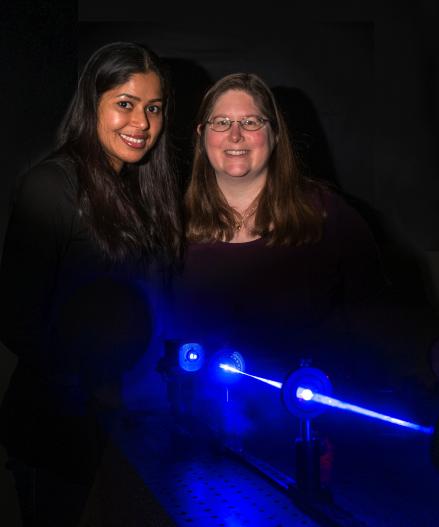The most effective way to tackle debilitating diseases is to punch them at the start and keep them from growing.
Research at Michigan State University, published in the Journal of Biological Chemistry, shows that a small “molecular tweezer” keeps proteins from clumping, or aggregating, the first step of neurological disorders such as Parkinson’s disease, Alzheimer’s disease and Huntington’s disease.
The results are pushing the promising molecule toward clinical trials and actually becoming a new drug, said Lisa Lapidus, MSU associate professor of physics and astronomy and co-author of the paper.
“By the time patients show symptoms and go to a doctor, aggregation already has a stronghold in their brains,” she said. “In the lab, however, we can see the first steps, at the very place where the drugs could be the most effective. This could be a strong model for fighting Parkinson’s and other diseases that involve neurotoxic aggregation.”
Lapidus’ lab uses lasers to study the speed of protein reconfiguration before aggregation, a technique Lapidus pioneered. Proteins are chains of amino acids that do most of the work in cells. Scientists understand protein structure, but they don’t know how they are built – a process known as folding.
Lapidus’ lab has shed light on the process by correlating the speed at which an unfolded protein changes shape, or reconfigures, with its tendency to clump or bind with other proteins. If reconfiguration is much faster or slower than the speed at which proteins bump into each other, aggregation is slow, but if reconfiguration is the same speed, aggregation is fast.
Srabasti Acharya, lead author and doctoral candidate in Lapidus’ lab, tested the molecule, CLR01, which was patented jointly by researchers at the University of Duisburg-Essen (Germany) and UCLA. CLR01 binds to the protein and prevents aggregation by speeding up reconfiguration. It’s like a claw that attaches to the amino acid lysine, which is part of the protein.
This work was preceded by Lapidus’ research involving the spice curcumin. While the spice molecules put the researchers on a solid path, the molecules weren’t viable drug candidates because they cannot cross the blood-brain barrier, or BBB, the filter that controls what chemicals reach the brain.
It’s the BBB, in fact, that disproves the notion that people should simply eat more spicy food to stave off Parkinson’s disease.
Spicy misconceptions notwithstanding, CLR01 mimics curcumin molecules’ ability to prevent aggregation. But unlike the spice, CLR01 can crossover the BBB and treat its targeted site. Not only do they go to the right place, but CLR01 molecules also work even better because they speed up reconfiguration even more than curcumin. Additionally Acharya showed that CLR01 slows the first step of aggregation, and the results from the study map out a clear road map for moving the drug to clinical trials.
Hearing about a nontraditional physics lab that was advancing medicine is what brought Acharya to work with Lapidus.
“I knew I wanted to study physics when I came to MSU, but when I heard Dr. Lapidus’ presentation during orientation, I knew this is what I wanted to do,” Acharya said. “We are using physics to better understand biology to help cure actual diseases.”



I think this method for treating debilitating diseases of the brain is crucial. Looking at ways to prevent a disease instead of cure the disease after it has attacked the body is definitely the forward thinking view of medicine these days.
I read another article on research into treating these diseases but with the use of stem cells which differentiate into new neurons, but I think this way of treating diseases is far more beneficial to a patient. Rather stop the disease before it can become a massive task to tackle.
This treatment, however, would have to ensure that patients go for checkups to check if their proteins are starting to aggregate so that the CLR01 molecule can start working at the correct time.
I think it is also fantastic how these physicists are pushing for this treatment to be allowed onto the market as so much research into new medical treatments remain in the lab for far to long.
I find it fascinating that the research done by the Michigan State University has identified the so called “clumping of proteins”in the brain as the start of certain neurological disorders.By stopping or reversing the proteins’s “clumping” process early-on neurological disorders could be treated more effectively. This could lead to a better quality of life for many elderly people who would otherwise be crippled by a neurological disorder and be confined to an infirmary or care center. Savings to the economy and stress and concern to the patients family will be greatly reduced.
This is a very interesting article and could help people to make wiser decisions when it comes to binge drinking. We all know that alcohol is bad for you but no one actually knows why. This article gives a clear description as to why excessive consumption of alcohol is bad for you. It is one of the many reasons why alcohol is bad for the human body. According to another website (http://www.niaaa.nih.gov/alcohol-health/alcohols-effects-body) , alcohol also makes the liver more prone to alcoholic hepatitis, this is inflammation of the liver. This could lead to the liver enlarging and as a result a person has problems with blood clotting and excessive bleeding. Key functions of the liver also include managing infections and absorbing nutrients, excessive drinking damages the liver and in turn, these functions cannot be performed affecting the immune system once again. Although all these conditions are reversible if you were to abstain from alcohol, heavy drinkers make it more difficult for the body to recuperate and that is why people who are binge drinkers should be warned about these conditions and educated about the effects of alcohol. A meeting that alcoholics can attend is a good start.